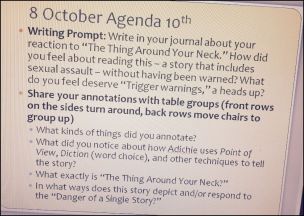I observed a high school English teacher and furthered my understanding of classroom management techniques that facilitate a conducive learning environment. Specifically, I observed this educator’s proficiency in 5.1 Component 2a: Creating an Environment of Respect and Rapport. This means that students understand that each decision the educator makes is rooted in the students’ best interests. Once students build this understanding through the teacher’s consistent diligence to this high standard; respect and rapport naturally form. This commitment was evident in my observation. I observed the educator provide a platform for students to express their thoughts regarding an assignment that upset several students based on the sensitive nature of a specific paragraph in the assigned reading. Rather than continuing the class without addressing the issue, figure 1.1 exemplifies how the educator used this adverse situation to open dialogue between students.
The educator altered the day’s agenda and students were encouraged to individually form their opinions in written form, and then invited to come together as a class to discuss those views. All opinions were valued, regardless if they disagreed with the educator or questioned the assignment. This revealed to all students, particularly those highly offended, the educator’s genuine care and willingness to listen, which resulted in the development of an approach to avoid similar occurrences in the future. The implementation of this strategy was formed by the collaborative opinions of the students, not the educator. In addition, the educator spoke with several students one-on-one to continue the conversation and to reiterate his understanding for their frustrations. It was evident that students were appreciative of this open forum and gained trust through the sincerity of the educator. Furthermore, students’ trust and respect only grew for the educator with consistent instances of empathy and authenticity. I observed a student share with the educator sensitive information about her mother’s recent cancer diagnoses. The educator received an email from one of the parents after the student’s conversation with the educator. The student felt comfortable sharing this information face-to-face with educator rather than waiting for them to receive the email from the parent. This shows a deep level of interpersonal connection between the student and educator. In The First Days of School: How to Be an Effective Teacher Relationships, Wong and Wong state, “Relationships are created in an effectively run classroom. There is a trusting relationship between effective teacher and the students. Finding out about the students is important in an effectively run classroom” (Chapter 1).
It is evident through this observation how an educator’s commitment to students, ability to listen and acceptance of responsibility when necessary can further relationships. These relationships serve as the foundation for learning and benefit all other aspects of classroom management. I will use this observation as an example for building trust and respect through authenticity. Though, these meaningful relationships are not built over night. It is easy for future educators like myself to emphasize a mutual trust and respect with students, but the desired product is much more complicated. An accurate evaluation of my effectiveness can be measured by the amount of students who feel comfortable approaching me with these sensitive issues that are shared exclusively with educators who students truly respect and trust.
References

